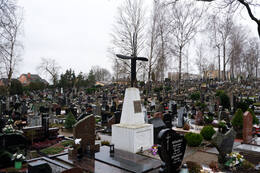Tomas Algirdas Zauka
IV Soviet Occupation, I Wars of Independence, II World War II
Tomas Algirdas Zauka (September 21, 1899 – January 21, 1970) was a pilot, one of the pioneers of Lithuanian sports aviation and an active public figure, especially deserving of preserving the memory of Darius and Girėnas. He was born in Rūmiškės farmstead, Obeliai rural municipality, Zarasai county, into a large peasant family, where he grew up with four brothers and two sisters. After graduating from elementary school, he learned to play the organ from a local organist.
In 1919-1922, T. Zauka served as a volunteer in the Lithuanian Army, was a private in the Kaunas County Commandant's Office. In 1923, he participated in the Klaipėda Region Command Operation. For his service, he was awarded the Lithuanian Army Volunteers' Medal (1929).
After completing private accounting courses, he worked in the Tax Department of the Ministry of Finance from 1922 to 1940. During this period, he met and started a family with Bronislava Vaitkevičiūtė. In 1926-1933, he studied at the Faculty of Technology of Vytautas Magnus University, but did not complete his studies for personal reasons.
In 1930, T. Zauka graduated from the first civil pilot courses organized by the Lithuanian Aeroclub and was one of four to receive pilot certificates. Later, he worked at the Aeroclub on a public basis – he was a member of the revision commission, and from 1937 – a member of the board.
During the war, T. Zauka worked at the Museum of the Red Terror and the Vilnius City Municipality. In 1940-1944, he headed the S. Darius and S. Girėnas Committee, which was registered in his house in Žaliakalnis. In 1942-1943, he organized and collected donations for the carving of relief portraits of S. Darius and S. Girėnas in the Puntukas Stone (sculptor Bronius Pundzius). The craftsmen carved the stone secretly, having built a wooden shed above it.
In 1944, as the front approached, T. Zauka, together with aviation captain Ignas Vylius, took care of preserving the remains of the legendary pilots. With the help of the staff of the VMU Faculty of Medicine, the coffins with the remains of the pilots were moved from the faculty chapel to the basement and walled up in a niche in the wall, where they remained for 20 years.
After the war, T. Zauka came under the sights of the KGB and in 1945-1952 was exiled to the Northern camps (Pečiara, Yersov in the Arkhangelsk region, Vorkuta, Komi). After returning from exile, he settled in Kuršėnai and worked as a builder. In 1963, while preparing to commemorate the 30th anniversary of the death of the transatlantic pilots, he helped to reveal the place where their remains were hidden.
In 1969, T. Zauka was involved in a mysterious accident, in which he was seriously injured, and soon after, another attempt was made on him. Having not recovered from his injuries, he died in Kuršėnai on January 21, 1970. He was buried in the Kuršėnai old cemetery on Užmiesčio Street, his grave is decorated with a pilot's tombstone with a cross of two crossed propellers.
More information sources
Related objects
Grave of Lithuanian volunteer and public figure Tomas Algirdas Zaukas
The grave of Lithuanian volunteer and public figure Tomas Algirdas Zauka is located in the Kuršėnai Old Cemetery.
Tomas Algirdas Zauka (1899 – 1970) was a Lithuanian pilot and public figure, a pioneer of sports aviation in Lithuania. TA Zauka became famous in 1944. together with aviation captain I. Vylius, for hiding the remains of transatlantic pilots from the Soviet occupiers. With the help of VMU Faculty of Medicine employees, the coffins with the remains of the pilots were moved from the chapel of the Faculty of Medicine to the basement and walled up in a niche in the wall, where the bodies of the pilots remained for 20 years. In 1963. while preparing to commemorate the 30th anniversary of the death of the transatlantic pilots, he helped reveal the place where their remains were hidden.
During the Nazi occupation, wishing to erect a monument to S. Darius and S. Girėnas in Kaunas, but realizing that political circumstances might prevent this, TA Zauka came up with the idea of perpetuating the memory of the pilots in Anykščiai - in 1942–1943. he collected donations and organized the carving of relief portraits of S. Darius and S. Girėnas in the Puntukas stone. Later, he was tried for this and sent to a camp.
In 1945–1952, he was imprisoned in the Pechora, Yertsovo (Arkhangelsk region), and Vorkuta camps, returning to Lithuania in 1953. He died under unclear circumstances in 1970, while under the watchful eye of the KGB.
Today, you can visit his grave with its distinctive tombstone, decorated with a cross of two crossed propellers.








